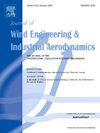利用自由端脉动槽吸力控制三维壁装方形圆柱体的空气动力和近尾流
IF 4.2
2区 工程技术
Q1 ENGINEERING, CIVIL
Journal of Wind Engineering and Industrial Aerodynamics
Pub Date : 2024-10-13
DOI:10.1016/j.jweia.2024.105917
引用次数: 0
摘要
为了控制长径比 H/d = 5 的三维壁装方形气缸的气动力和近尾流,在其自由端前缘采用了脉动槽吸力。本实验在雷诺数 Re = 2.74 × 104 的风洞中进行。脉动吸力比 f∗ 定义为脉动吸力频率 fs 与涡流脱落频率 fv 之比,范围为 0 至 1.6,对应的动量系数 Cμ 范围为 0-0.03。脉动槽吸力可大大降低气缸的整体波动阻力 Cd′和波动升力 Cl'。气动抑制效果随 f∗ 的增大而增强,在 f∗ ≥ 0.6 时趋于稳定(Cμ ≥ 0.014)。当 f∗ = 0.6 时,整体 Cd‾、Cd′ 和 Cl' 分别降低了 2.7%、22.2% 和 50.1%。脉动吸力控制使自由端剪切流周期性地重新附着到圆筒的自由端,在圆筒下游形成大尺度涡旋结构,增强了尾流与自由流之间的动量交换。另一方面,虽然跨向涡流脱落的强度明显减弱,但其频率在所有测试 f∗ 下均保持不变。粒子图像测速仪(PIV)的结果表明,气缸尾流中的湍流动能显著降低。使用适当正交分解法(POD)进行的分析表明,近尾流涡旋结构的周期性明显减弱。本文章由计算机程序翻译,如有差异,请以英文原文为准。
Control of the aerodynamic forces and the near wake of a 3D wall-mounted square cylinder using pulsing slot suction at its free end
To control the aerodynamic forces and near wake of a 3D wall-mounted square cylinder with an aspect ratio H/d = 5, pulsing slot suction is employed at its free-end leading edge. The present experiment is investigated in a wind tunnel with Reynolds number Re = 2.74 × 104. The pulsing suction ratio f∗, defined as the ratio of the pulsing suction frequency fs to the vortex shedding frequency fv, ranges from 0 to 1.6, corresponding to a momentum coefficient range of 0–0.03. The pulsing slot suction can greatly reduce the overall fluctuating drag and fluctuating lift of the cylinder. Aerodynamic suppression effect enhances with increasing f∗, and becomes stable for f∗ ≥ 0.6 ( ≥ 0.014). At f∗ = 0.6, the overall , and are reduced by 2.7%, 22.2% and 50.1%, respectively. The pulsing suction control causes periodic reattachment of the free-end shear flow to the cylinder's free end, forming large-scale vortex structures downstream of the cylinder, and enhancing the momentum exchange between wake and free flow. On the other hand, although the strength of spanwise vortex shedding is obviously weakened, its frequency remains unchanged at all tested f∗. Results from particle image velocimetry (PIV) show that the turbulent kinetic energy in the cylinder wake is significantly reduced. Analyses using the proper orthogonal decomposition (POD) demonstrate that the periodicity of near-wake vortex structure is significantly suppressed.
求助全文
通过发布文献求助,成功后即可免费获取论文全文。
去求助
来源期刊
CiteScore
8.90
自引率
22.90%
发文量
306
审稿时长
4.4 months
期刊介绍:
The objective of the journal is to provide a means for the publication and interchange of information, on an international basis, on all those aspects of wind engineering that are included in the activities of the International Association for Wind Engineering http://www.iawe.org/. These are: social and economic impact of wind effects; wind characteristics and structure, local wind environments, wind loads and structural response, diffusion, pollutant dispersion and matter transport, wind effects on building heat loss and ventilation, wind effects on transport systems, aerodynamic aspects of wind energy generation, and codification of wind effects.
Papers on these subjects describing full-scale measurements, wind-tunnel simulation studies, computational or theoretical methods are published, as well as papers dealing with the development of techniques and apparatus for wind engineering experiments.

 求助内容:
求助内容: 应助结果提醒方式:
应助结果提醒方式:


